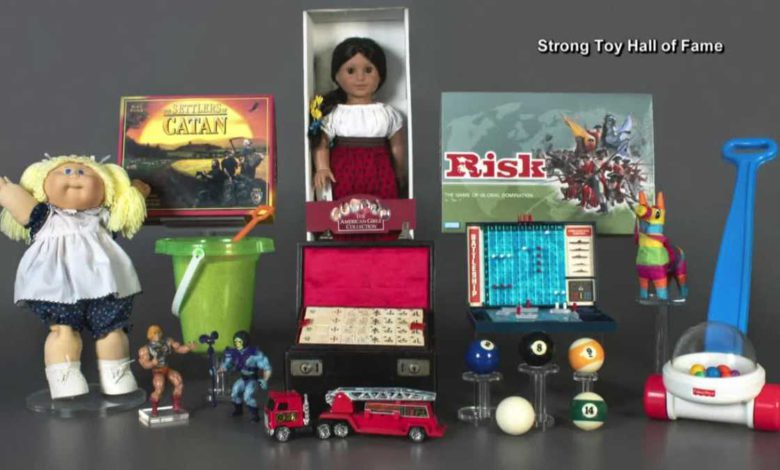
Mhm Mhm Right.
Meet the 2021 National Toy Hall of Fame finalists
The following 12 toys are finalists for 2021 induction into The Strong’s National Toy Hall of Fame. Only three will take their honored places in the hall this year when they are announced by The Strong on Thursday, Nov. 4, at 10:30 a.m.“These 12 toys represent the wide scope of playthings — from one of the most universal playthings in the world like sand to a game-changing board game like Risk to the popular adult game of billiards,” said Christopher Bensch, vice president for collections at The Strong. “Whether old or new, for kids or adults, all 12 of these toy finalists greatly influenced the world of play.”American Girl DollsCreated in 1986 by educator and newscaster Pleasant Rowland, the 18-inch American Girl dolls (and their accompanying books) explore America’s social and cultural history. Each doll comes with a unique narrative that fits her era, such as Molly McIntire, who is waiting for her father to return home from World War II. The Pleasant Company released the My American Girl line of dolls in 1995 (originally under the name American Girl Dolls of Today) and designed them to look like their owners. BattleshipOriginally a pencil-and-paper game, Battleship’s inspiration began with similar two-person strategy games in the late 19th century. Various manufacturers printed paper versions beginning in the 1930s and Milton Bradley’s 1967 plastic adaptation became a hit. The game was among the first board games to be computerized in 1979, and today countless electronic versions exist. BilliardsBilliards is a blanket term for many different cue sports, but pool—or pocket billiards—is the most common term in the United States. The game evolved from earlier European outdoor games, like croquet in the 14th and 15th centuries, and became extremely popular in the 1800s. While the dedicated poolhalls of yesteryear may be mostly gone, billiards remains a popular form of adult play in arcades, restaurants, bars, and entertainment centers.Cabbage Patch KidsWhen Cabbage Patch Kids launched in 1979, they offered American children a soft, cuddly playmate in a world of hard toys and cold electronics. Consumers could not get enough of the dolls, each with its own name, its unique, lumpy rounded face, and adoption papers. They became the must-have holiday toy of 1983 and generated massive demand, paving the way for later holiday crazes around Tickle Elmo, Beanie Babies, and Furby. For more than 40 years, these dolls have expanded children’s notions of play and fantasy, of beauty and belonging.Fisher-Price Corn PopperFisher-Price introduced the Corn Popper in 1957, calling it an amusement device for young children. Parents quickly discovered that by pushing the device, children could strengthen gross motor skills, and it has become a staple toy for toddlers ever since. The bright, flying balls and popping sound also help to stimulate the senses, promoting curiosity and discovery.MahjongMahjong (also known as Mah-Jongg) evolved from 18th and 19th-century gambling card games in China. Variations spread to Korea, Japan, and other areas of Asia before becoming popular in the United States in the 1920s. Standard Chinese Mah-Jongg played like American gin rummy but was changed in the 1930s when the National Mah Jongg League established more formal and limited rules. According to the 2021 book Mahjong: A Chinese Game and the Making of Modern American Culture, the game caught on with Hollywood starlets, high-society, middle-class housewives, and immigrants and “signified both belonging and standing apart in American culture.”Masters of the UniverseThe Master of the Universe line of action figures, which includes the iconic He-Man and She-Ra, traces its popularity to maker Mattel’s use of comic books, television, and the big screen. The cartoon series He-Man and the Masters of the Universe, which ran from 1983 to 1985, created a cohesive, fantasy world that allowed Mattel to introduce new characters and new toys to the line. Over the years, Mattel has paired the brand with everything from toothbrushes to sleeping bags.PiñataAs the centerpiece of a party game, a piñata is a paper mâché object filled with small toys, confetti, fruits, candies, or coins and raised high with rope. Both children and adults can play; while blindfolded, players swing a stick and try to break open the piñata and shower guests with the treats inside. Commonly associated with Mexican culture, the object may date back to early 13th-century China. Although there is an inherent impermanence to the piñata as a plaything, it has been and continues to be used in religious and secular celebrations all over the world.RiskBased on the French game Le Conquete du Monde, Risk translates the hobby of wargaming with miniature figures into a mass-produced war and strategy board game. First published in the United States in 1959, Risk challenges players to control armies and conquer the world. The game’s innovative mechanics ignited renewed interest in strategy games in the 1970s and continues to influence the board game industry.SandSand may be the most universal and oldest toy in the world. Educator Maria Montessori has argued that sand “is only one substance that the modern child is allowed to handle quite freely.” Children recognize sand as a creative material suitable for pouring, scooping, sieving, raking, and measuring. Wet sand is even better, ready for kids to construct, shape, and sculpt. Sand provides unique opportunities for tactical, physical, cooperative, creative, and independent free play.The Settlers of CatanThe Settlers of Catan, now called “Catan,” was first published by Kosmos in Germany. It’s one of the first German-style board games to find widespread popularity outside of Europe. It is a cooperative game in which players representing settlers establish a settlement on an island by spending resources, which are earned through trade and rolls of the dice. It’s been called the “game of our time” by the Washington Post, is sold in more than 30 languages, and has won multiple international awards in game design.Toy Fire EngineAlthough toy fire engines have evolved in materials, design, and technology over time, the benefits of play with these vehicles remain the same. A child might use a toy fire engine to explore role playing by assuming the position of a firefighter or person in danger. A child might spin the wheels or extend the ladder to test the capabilities of a toy fire engine. This variety of possibilities allows a child to practice communication skills, cognitive flexibility, and to explore risk, technical competence, and emotional fortitude.
The following 12 toys are finalists for 2021 induction into The Strong’s National Toy Hall of Fame. Only three will take their honored places in the hall this year when they are announced by The Strong on Thursday, Nov. 4, at 10:30 a.m.
“These 12 toys represent the wide scope of playthings — from one of the most universal playthings in the world like sand to a game-changing board game like Risk to the popular adult game of billiards,” said Christopher Bensch, vice president for collections at The Strong. “Whether old or new, for kids or adults, all 12 of these toy finalists greatly influenced the world of play.”
American Girl Dolls
Created in 1986 by educator and newscaster Pleasant Rowland, the 18-inch American Girl dolls (and their accompanying books) explore America’s social and cultural history. Each doll comes with a unique narrative that fits her era, such as Molly McIntire, who is waiting for her father to return home from World War II. The Pleasant Company released the My American Girl line of dolls in 1995 (originally under the name American Girl Dolls of Today) and designed them to look like their owners.
Battleship
Originally a pencil-and-paper game, Battleship’s inspiration began with similar two-person strategy games in the late 19th century. Various manufacturers printed paper versions beginning in the 1930s and Milton Bradley’s 1967 plastic adaptation became a hit. The game was among the first board games to be computerized in 1979, and today countless electronic versions exist.
Billiards
Billiards is a blanket term for many different cue sports, but pool—or pocket billiards—is the most common term in the United States. The game evolved from earlier European outdoor games, like croquet in the 14th and 15th centuries, and became extremely popular in the 1800s. While the dedicated poolhalls of yesteryear may be mostly gone, billiards remains a popular form of adult play in arcades, restaurants, bars, and entertainment centers.
Cabbage Patch Kids
When Cabbage Patch Kids launched in 1979, they offered American children a soft, cuddly playmate in a world of hard toys and cold electronics. Consumers could not get enough of the dolls, each with its own name, its unique, lumpy rounded face, and adoption papers. They became the must-have holiday toy of 1983 and generated massive demand, paving the way for later holiday crazes around Tickle Elmo, Beanie Babies, and Furby. For more than 40 years, these dolls have expanded children’s notions of play and fantasy, of beauty and belonging.
Fisher-Price Corn Popper
Fisher-Price introduced the Corn Popper in 1957, calling it an amusement device for young children. Parents quickly discovered that by pushing the device, children could strengthen gross motor skills, and it has become a staple toy for toddlers ever since. The bright, flying balls and popping sound also help to stimulate the senses, promoting curiosity and discovery.
Mahjong
Mahjong (also known as Mah-Jongg) evolved from 18th and 19th-century gambling card games in China. Variations spread to Korea, Japan, and other areas of Asia before becoming popular in the United States in the 1920s. Standard Chinese Mah-Jongg played like American gin rummy but was changed in the 1930s when the National Mah Jongg League established more formal and limited rules. According to the 2021 book Mahjong: A Chinese Game and the Making of Modern American Culture, the game caught on with Hollywood starlets, high-society, middle-class housewives, and immigrants and “signified both belonging and standing apart in American culture.”
Masters of the Universe
The Master of the Universe line of action figures, which includes the iconic He-Man and She-Ra, traces its popularity to maker Mattel’s use of comic books, television, and the big screen. The cartoon series He-Man and the Masters of the Universe, which ran from 1983 to 1985, created a cohesive, fantasy world that allowed Mattel to introduce new characters and new toys to the line. Over the years, Mattel has paired the brand with everything from toothbrushes to sleeping bags.
Piñata
As the centerpiece of a party game, a piñata is a paper mâché object filled with small toys, confetti, fruits, candies, or coins and raised high with rope. Both children and adults can play; while blindfolded, players swing a stick and try to break open the piñata and shower guests with the treats inside. Commonly associated with Mexican culture, the object may date back to early 13th-century China. Although there is an inherent impermanence to the piñata as a plaything, it has been and continues to be used in religious and secular celebrations all over the world.
Risk
Based on the French game Le Conquete du Monde, Risk translates the hobby of wargaming with miniature figures into a mass-produced war and strategy board game. First published in the United States in 1959, Risk challenges players to control armies and conquer the world. The game’s innovative mechanics ignited renewed interest in strategy games in the 1970s and continues to influence the board game industry.
Sand
Sand may be the most universal and oldest toy in the world. Educator Maria Montessori has argued that sand “is only one substance that the modern child is allowed to handle quite freely.” Children recognize sand as a creative material suitable for pouring, scooping, sieving, raking, and measuring. Wet sand is even better, ready for kids to construct, shape, and sculpt. Sand provides unique opportunities for tactical, physical, cooperative, creative, and independent free play.
The Settlers of Catan
The Settlers of Catan, now called “Catan,” was first published by Kosmos in Germany. It’s one of the first German-style board games to find widespread popularity outside of Europe. It is a cooperative game in which players representing settlers establish a settlement on an island by spending resources, which are earned through trade and rolls of the dice. It’s been called the “game of our time” by the Washington Post, is sold in more than 30 languages, and has won multiple international awards in game design.
Toy Fire Engine
Although toy fire engines have evolved in materials, design, and technology over time, the benefits of play with these vehicles remain the same. A child might use a toy fire engine to explore role playing by assuming the position of a firefighter or person in danger. A child might spin the wheels or extend the ladder to test the capabilities of a toy fire engine. This variety of possibilities allows a child to practice communication skills, cognitive flexibility, and to explore risk, technical competence, and emotional fortitude.
Source link









